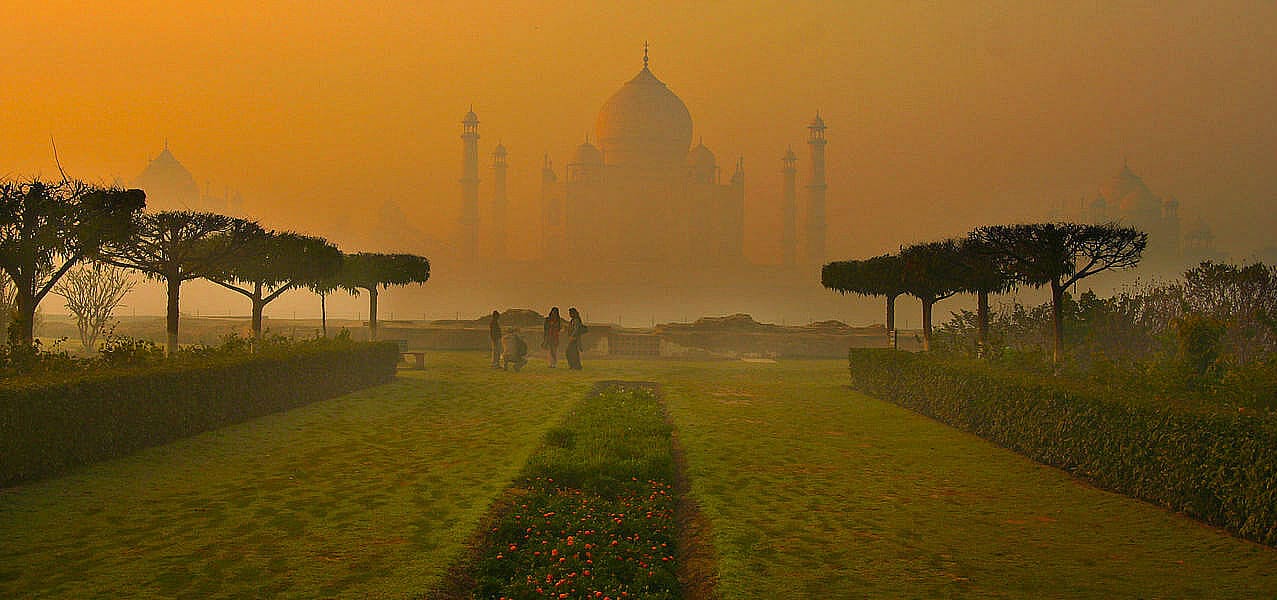Although the city has become synonymous with the world famous Taj Mahal, there’s more to Agra than this fascinating architectural wonder. In fact, there is an emperor’s wealth of things to do in Agra, especially for those who love history, nature, and wildlife.
With three UNESCO World Heritage Sites (the Taj Mahal, Agra Fort, and Fatehpur Sikri), Agra is a haven for history lovers. In fact, the city is as old as India’s ancient epic tale, the Mahabharata.
It originally became famous as Akbarabād, when the Mughal ruler Sultan Sikandar Lodī made it the capital of the Mughal Empire from 1556 to 1658. Having undergone many changes after the decline of the Mughal Empire, it fell under the influence of Marathas and then the British Raj.
For nature and wildlife lovers, the city (part of India’s “golden triangle” tourism circuit) offers an array of botanical gardens to explore and wildlife rescue/rehabilitation facilities you can visit.
Local NGO Wildlife SOS even has a volunteer program working with amazing animals such as Sloth Bears and Asian Elephants. Volunteers stay in a beautiful area of the SOS sanctuary, surrounded by birds and animals, and all proceeds help to fund their conservation efforts.
Here’s a look at our picks for 10 of the best things to do in Agra, India for nature and history lovers.
READ MORE: Ranthambore National Park – On the Trail of Tigers in India
1. Volunteer at the Agra Bear Rescue Facility
I first heard about the Agra Bear Rescue Facility when I watched a TED Talk by its co-founder, Kartick Satyanaran. In it, he discussed how Wildlife SOS launched a successful campaign to rescue every “dancing” bear in India.
Wildlife SOS put the final nail in the coffin of this cruel, centuries-old practice of capturing juvenile Sloth Bears in the wild and training them to “dance” using torture and cruel training practices.
It was to the NGO’s credit that they achieved this without punishing the practitioners, the marginalized Kalandar community. Instead, the community-based tourism initiative helps the Kalandar people find alternative sources of sustainable income through the Kalandar Rehabilitation Program.
Established in 1999, the Agra Bear Rescue Facility currently houses around 200 sloth bears and other species of wildlife in large forested enclosures with ponds and shady trees. All of them were rescued from horrific lives as dancing bears, poaching, or situations of human conflict.
A 2-hour visit includes a guided tour, a documentary about India’s dancing bears, and a discussion with experts about the challenges of bear conservation in India. In addition, you’ll watch the rescued bears as they play, forage, climb trees, dig, and interact with their keepers.
If you volunteer with Wildlife SOS, you’ll have the unique opportunity to work alongside these incredible animals. You’ll spend five days building hammocks for Sloth Bears to rest in, constructing enrichment structures for play, and assisting keepers on daily afternoon feedings.
READ MORE: Saving Endangered Asian Animals (Best Conservation Programs)
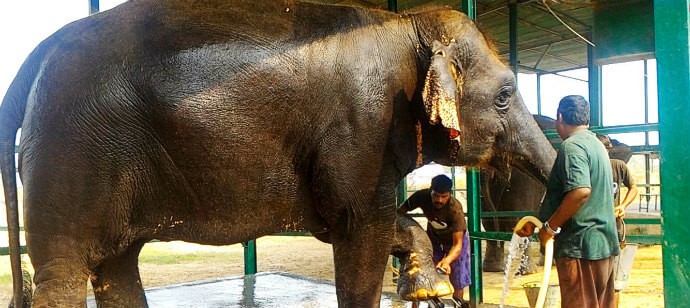
2. Visit the Elephant Conservation & Care Center
Inspired by the work that Wildlife SOS was doing with rescued Asian Elephants and bears, I wanted to visit the Elephant Conservation & Care Center in Mathura and see it for myself.
Improving captive elephant welfare and rescuing performing elephants is something Wildlife SOS has been associated with for many years.
If you’re just visiting, Wildlife SOS can help arrange transport to and from Agra to the ECCC in Mathura (which is a couple of hours drive away) as long as you contact them in advance.
As a visitor, you can meet the elephants, learn about the circumstances they were rescued from, help bathe them, and also accompany them on their evening walk.
If you volunteer, you get to spend a few days enjoying the opportunity to visit with them, put up enrichments for them, and help with their feeding and/or giving them a bath.
READ MORE: 50 Fascinating Facts About Elephants
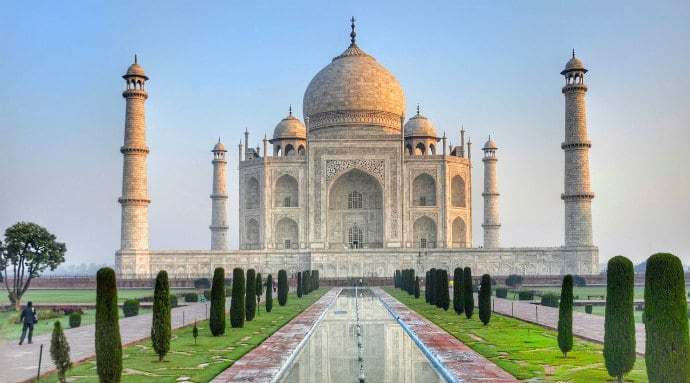
3. Marvel at the Beauty of the Taj Mahal
A visit to the Taj Mahal is essentially a must for any traveler who passes through Agra. Built by Shah Jahan in 1631 as a memorial for his third wife, Mumtaz Mahal, the Taj is the reason why most tourists visit Agra in the first place.
A testament to Shah Jahan’s grief after his wife died giving birth to their 14th child, it’s a marvel of classic Mughal architecture.
Unfortunately for the emperor, his own son Aurangzeb ultimately imprisoned him in the Agra Fort. There, he spent his last days gazing at his beloved’s shrine until he joined her in death and was buried in the tomb right next to hers.
The platforms beneath the structure are made from sandstone and marble. Small domes, numbering 22 to commemorate the years it took to build the monument, adorn the top of the gate. The inscriptions in the walls represent verses from the Quran.
Red sandstone structures- mirror images of one another- bookend the Taj on either side. On the left is a Mosque, and on the right is a guest house called the Mehman Khana.
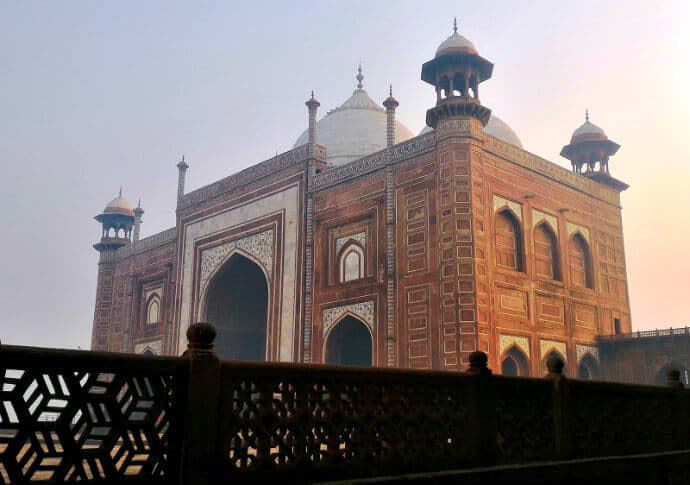
There are minor differences in each structure. For instance, in the mosque, the flooring is designed to simulate 596 prayer mats.
The Wuzu water tank in front of the mosque is for the purpose of cleansing one’s body parts before namaz, or worship.
There are gardens, residential quarters, the Gateway, and two other tombs (belonging to the emperor’s other wives) that make up the other structures surrounding the main structure. These are also well worth a visit.
New restrictions have recently been put in place in an effort to protect the ancient site from the negative impacts of overtourism. Entry to the monument has been restricted to 40,000 tourists daily, and a three-hour cap imposed on each visit.
READ MORE: How Mass Tourism Is Destroying 30+ Destinations Travelers Love
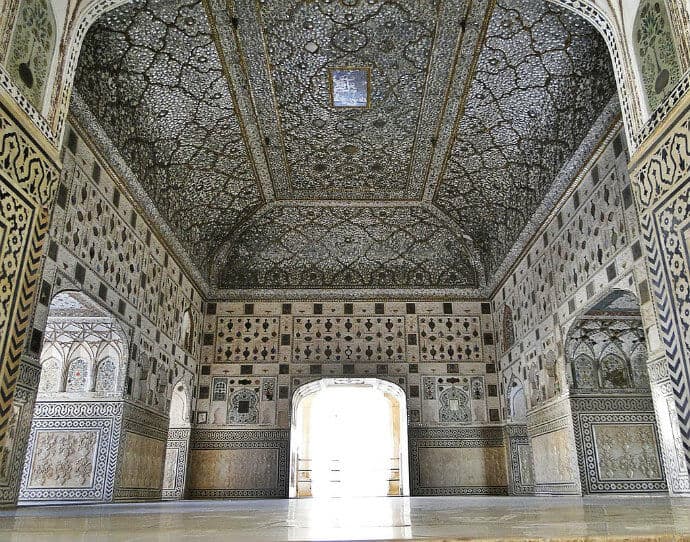
Reflect at Sheesh Mahal in the Agra Red Fort
Built by Shah Jahan, the Sheesh Mahal (Mirror Palace) was a Royal dressing room located inside the Agra Fort, which was the domain of the emperor’s queens.
It is a stunning hall of mirrors, well-preserved and detailed. The intricate glass work in the ceiling reflects light to illuminate the room beautifully.
When occupied by the queens of old, these walls were inlaid with precious gems and diamonds. Unfortunately, those were stolen by the British when they occupied it. But the marks on the walls where the gems were removed are still visible.
Usually closed to the public, it is sometimes possible to catch a view of this unique room.
Located close to the Sheesh Mahal, you’ll find the Musamman or Shah Burj (an octagonal tower) and Anguri Bagh (a sprawling historical courtyard, with a formal charbagh-style garden). These are also worth a visit while you’re exploring the historic Agra Fort.
READ MORE: 10 Ancient Archaeological Sites (World Travel Bucket List)
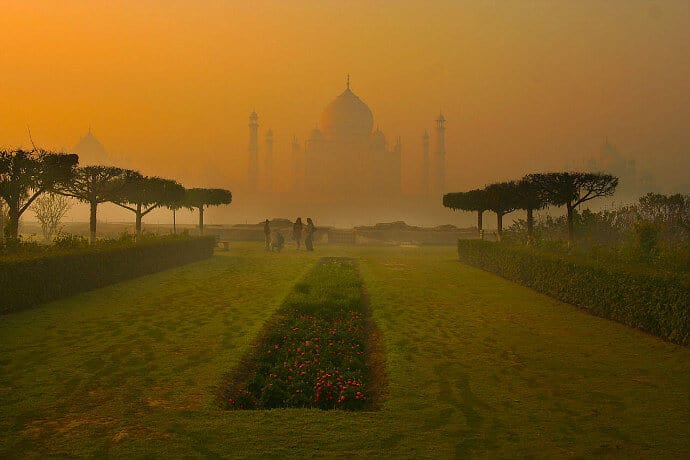
Wander in the Mehtab Bagh Garden
The Mehtab Bagh (Moonlight) Garden is a square complex, built by Emperor Babur, that actually predates the Tāj Mahal.
This was the last of 11 Mughal gardens created along the Yamuna, opposite the Taj Mahal and the Agra Fort. It lies north of the Taj and in perfectly alignment with it, on the opposite side of the Yamuna River.
Created as a moonlit pleasure garden, the Mehtab Bagh was identified by Emperor Shah Jahan as an ideal location for viewing the Taj Mahal. So the garden was designed as an integral part of the complex in the riverfront terrace pattern.
Legend has it that Shah Jahan intended to build a Black Taj Mahal (a twin to the Taj Mahal) as a tomb for himself, but failed to do so before he was imprisoned by his son, Aurangzeb. The remains of what is thought to be the foundation of the Black Taj Mahal can be seen near the garden’s pond.
Entry to the garden is free, and security is tight. The garden is partially flooded during the rainy season, so the best time to visit is winter and early summer.
You can also see plenty of birds along the river and in the gardens. But do note that the garden gets crowded in the evenings, when the setting sun showcases the Taj Mahal in its most gorgeous light.
READ MORE: Interview with Zakir Hussain, India’s Legendary Percussionist
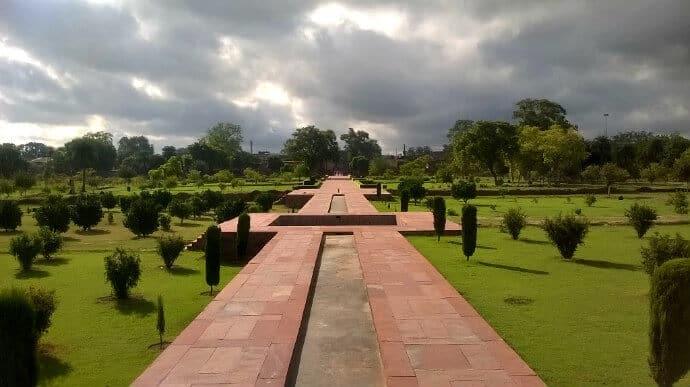
Explore the Aram (Ram) Bagh
This is the first Mughal garden of its type, laid out by the Mughal ruler Babur in 1528. He was buried here briefly, before his removal to Kabul. It is said that Akbar I (the third Mughal Emperor) proposed to his third wife, who was a gardener here, by lying idle for 6 days until she relented.
The garden is the first tourist attraction you can see when coming to Agra via the Yamuna Expressway. Originally called Aram Bagh (Garden of Repose), it was changed to Ram Bagh by the Marathas.
The garden is based on the Persian ideal of Paradise – an abundant garden through which rivers flow– and is divided by geometric water channels and water pools.
According to the CPR Environmental Education Centre, Aram Bagh provides an example of the charbagh, in which water flows down three terraces in a sequence of cascades.
It is local adjacent to the Yamuna River bank and has a long, raised, red sandstone walkway stretching to the banks of the river, with steps leading down to it. A variety of birds, monkeys, squirrels, and butterflies abound here.
Apparently Babur installed a Takkhana– an underground room which kept him cool in the heat of Agra’s unbearable summers– here.
Located about five kilometers northeast of the Taj Mahal, Aram Bagh is another great place from which to view and photograph the iconic monument. The garden is open on all days from sunrise to sunset, and you can visit it for an hour at a time.
READ MORE: The Ancient Ruins of Xunantunich
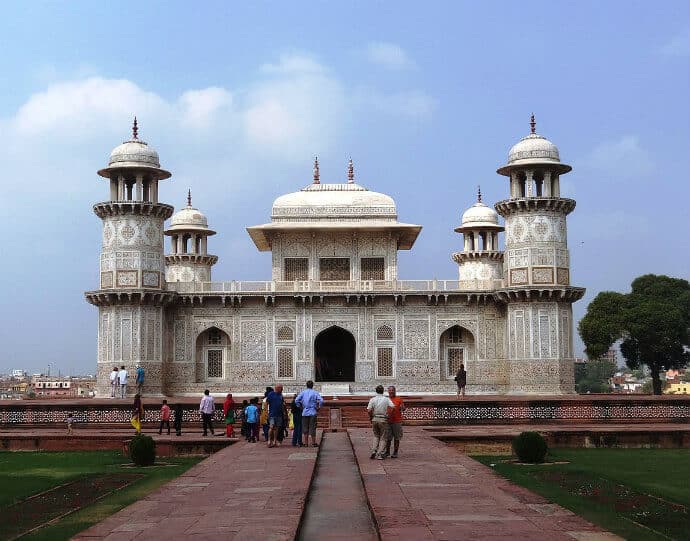
See the Tomb of Itimad Ud Daulah
This Mughal mausoleum was commissioned by Nūr Jahān, the wife of Jahangir, for her father Mirzā Ghiyās Beg. He was originally a Persian Amir living in exile, on whom had been conferred the title of I’timād-ud-Daulah (Pillar of the State).
Sometimes referred to as the “Baby Taj,” the monument was built between 1622 and 1628, and is often regarded as a draft of the Taj Mahal.
Like most Mughal structures, it consists of numerous outbuildings and is set in a large cruciform garden criss-crossed by water courses and walkways.
Architecturally, it represents a transition between the first phase of monumental Mughal architecture (which was built from red sandstone with marble decorations) and its second phase (which was based on white marble and pietra dura inlay).
The walls are white marble sourced from Rajasthan and encrusted with semi-precious stones. Delicate jālī screens of intricately carved white marble allow light to penetrate into the interior.
The cenotaphs of Nur Jahan’s parents are also placed side-by-side, in a fashion similar to that of Shah Jahan and and his wife’s tombs in the Taj Mahal.
READ MORE: Interview With Author Salman Rushdie on India’s History
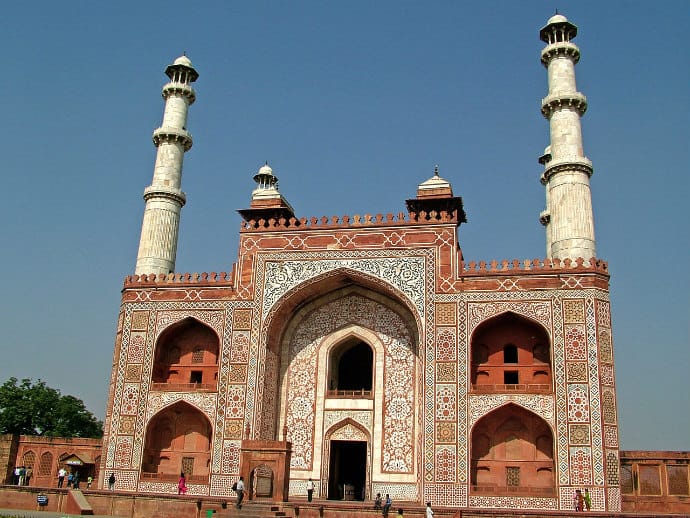
Visit Akbar’s Tomb at Sikandra
Akbar I was one of the most well-known Mughal Emperors, and his tomb is a significant Mughal architectural masterpiece.
Built in 1604–1613, Akbar’s Tomb is situated on 119 acres of grounds in Sikandra (a suburb of Agra) on the Mathura road (NH2).
The tomb is a four-tiered pyramid constructed from a deep red sandstone, enriched with features in white marble. It is surmounted by a marble pavilion containing the false tomb. As in other mausoleums, the true tomb is located in the basement.
The panel designs are geometric, floral, and calligraphic, heralding the complex and subtle designs later incorporated in Itmad-ud-Daulah’s Tomb.
The construction of the tomb was planned by Akbar himself, who selected a suitable site for it. It was completed by his son, Prince Salim (Jahangir). During the time of Mughal ruler Aurangzeb, the rebellious Jats ransacked this intricate tomb, plundering and looting all the gold, jewels, silver, and carpets.
The Jat ruler, Raja Ram, didn’t even leave Akbar’s tomb intact, instead opening the grave and dragging out the late emperor’s bones. This made Aurangzeb so furious that he captured Raja Ram and killed him. Over the last few centuries, the tomb has undergone extensive repairs.
READ MORE: The 16 Best Mayan Ruins & Pyramids to Explore
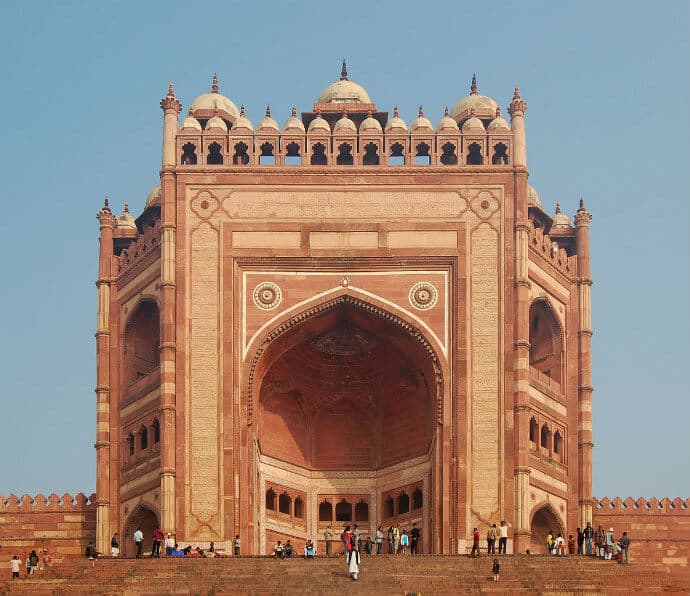
Traverse Buland Darwaza & Fatehpur Sikri
Measuring around 176 feet from ground level, Buland Darwaza (the “Gate of Magnificence”) is the tallest gate in the world. This majestic 15-story gateway was built in 1601 AD by Mughal Emperor Akbar I to commemorate his victory over the state of Gujarat.
Made of red and buff sandstone, and decorated with white and black marble, this imposing structure is the main entrance to the palace at Fatehpur Sikri, a town located 26 miles from Agra. The approach to the gate is via a flight of 42 steps that sweeps down the hill, giving the gateway additional height.
The gate is topped by large free standing kiosks, called chhatris. It is semi-octagonal in design, with two smaller triple-storied wings on either side. The principal arch forms the focal point of three projecting sides, topped by a dome and broken into three tiers, with rows of smaller arches and flat brackets.
A Persian inscription on the eastern archway records Akbar’s conquest over Uttar Pradesh and the victory in Gujarat in 1601. An inscription on the central face describes Akbar’s religious tolerance.
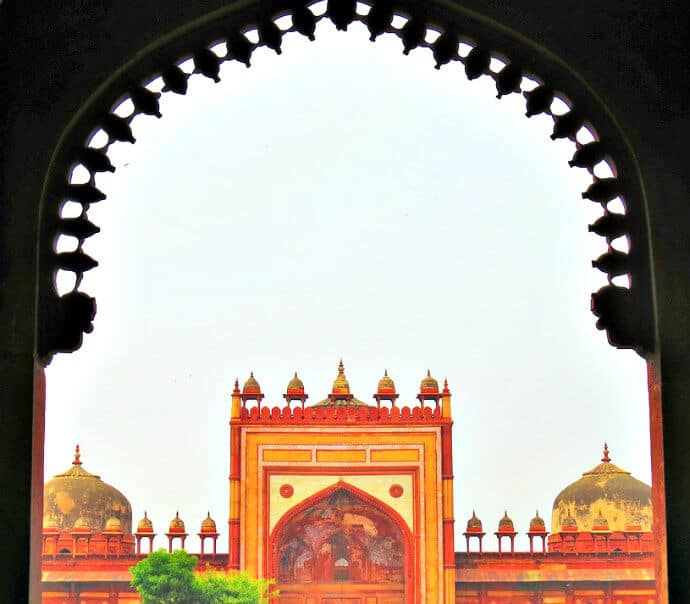
Fatehpur and Sikri are actually two places. Fatehpur is the fort and Sikri is the village where the famous saint Chisti lived. They are within walking distance from one another.
Fatehpur was the capital of the Mughal empire around 1570-1585, when Emperor Akbar moved his capital from Agra. However, due to the shortage of water, he was forced to shift the capital back to Agra.
Although the entry to the Fatehpur fort requires a ticket, the entry to Sikri (where the Jama Masjid, Buland Darwaza, and Chisti Dargah are based) is free.
Vehicles are not allowed to enter Fatehpur, so one has to park at the government designated parking. From there you can take Government-run buses that leave every few minutes to the Fort (Diwaan-E-Aam) complex or Sikri village.
Because there is no ticket to enter Sikri, you’ll find many touts trying to cheat you by claiming you need a ticket to enter (or playing on your sentiments for donations). Beware of these scammers, and hire a reputable and knowledgeable guide to take you around and explain the history of the place.
READ MORE: Anoushka Shankar on Indian Culture & Her Famous Father
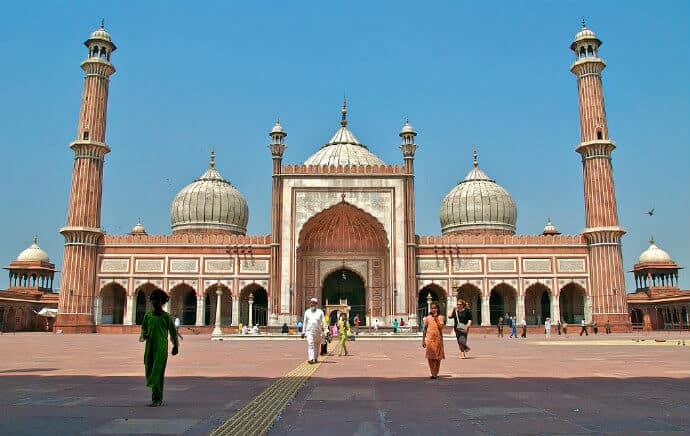
Photograph the Jama Masjid
Opposite the Agra fort, overlooking the Railway Station, you’ll find one of the largest mosques in India. It was built to enable 25,000 Muslims to pray together at once. Its stunning interior makes visiting the Jama Masjid one of the best things to do in Agra for photographers.
The mosque was built by Mughal Emperor Shah Jahan in 1648 and dedicated to his favorite daughter, Jahanara Begum. The beauty of Jama Masjid was once compared to Baitul Ma’mur, a house situated in the 7th heaven, directly above the Ka’aba on earth.
Made of red sandstone and marble, the mosque required six years and 5,000 workers to complete. It was once surrounded by a marketplace called Tripolia, which was built between the Delhi Gate and the Masjid. Unfortunately that was destroyed in 1871-73 in order to acquire space for the Agra Fort Railway Station.
The mosque has three gates and is surrounded by four tall towers and two minarets. You have to be dressed appropriately to visit Jama Masjid, but you can rent robes to put on over your travel clothes. Slippers are also provided.
There’s no entrance fee for visitors, but there is 300 rupee (around $4.46 US) camera fee. You will be asked for the ticket when you take pictures inside. The incredible architecture provides some great visual opportunities, so it’s definitely worth it! –Priya Florence Shah
Compare Hotel Prices in Agra, India
 Priya Florence Shah is an author and travel writer who blogs at AhoyMatey, where she chronicles her quest for responsible, sustainable, and family travel experiences around the world. You can connect with her on social media @PriyaFlorence. If you are a blogger who would like to pitch a guest post on Green Global Travel, please contact Editor In Chief Bret Love at info@GreenGlobalTravel.com.
Priya Florence Shah is an author and travel writer who blogs at AhoyMatey, where she chronicles her quest for responsible, sustainable, and family travel experiences around the world. You can connect with her on social media @PriyaFlorence. If you are a blogger who would like to pitch a guest post on Green Global Travel, please contact Editor In Chief Bret Love at info@GreenGlobalTravel.com.
